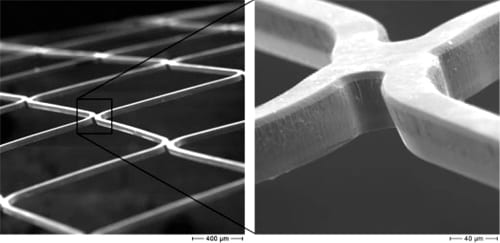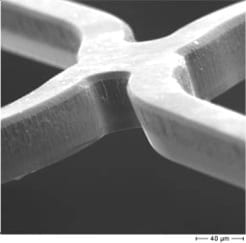For two reasons shape memory alloys basing on TiNi are highly interesting for medical implants and devices: on one hand they exhibit superelastic properties with superelastic strains larger than 8%, tensile strengths up to 1400 MPa, and breaking elongations up to 60%. On the other hand, the material has an excellent biocompatibility. Both features result in a high attractiveness for medical in vivo applications, for instance for stents, mesh tubes which are inserted to prevent or counteract flow constriction in the body.
However, micropatterning of these materials by UV lithography and etching is still a challenging task. Wet etching has severe design limitations due to its isotropic nature while dry etching shows much too low etching rates. In recent years, thin film technology has gained increasing interest in comparison to traditional bulk fabrication routes. Thus, further miniaturization of medical implants has become possible, allowing, for example, the fabrication of neurostents.
 Dr. Rodrigo Lima de Miranda and Dr. Christiane Zamponi together with Prof. Dr. Eckhard Quando from the University of Kiel in Germany tackled this subject. In a paper they present a method to fabricate micropatterned superelastic TiNi films with high thicknesses and high aspect ratios. This new method is based on UV lithography, sacrificial layers and wet etching technology. The possibility to use the under etching as an advantage will allow a high degree of freedom in the design in micropatterned TiNi film devices. In their work, the researchers characterize the mechanical properties and compare them to laser structured conventional TiNi sheets with the same dimensions.
Dr. Rodrigo Lima de Miranda and Dr. Christiane Zamponi together with Prof. Dr. Eckhard Quando from the University of Kiel in Germany tackled this subject. In a paper they present a method to fabricate micropatterned superelastic TiNi films with high thicknesses and high aspect ratios. This new method is based on UV lithography, sacrificial layers and wet etching technology. The possibility to use the under etching as an advantage will allow a high degree of freedom in the design in micropatterned TiNi film devices. In their work, the researchers characterize the mechanical properties and compare them to laser structured conventional TiNi sheets with the same dimensions.
Rodrigo Lima de Miranda and coworkers found that the TiNi film sample exhibits an elongation at fracture of more than 2.5-time higher compared to the conventional patterned TiNi sheet metal. However, both materials show a common plateau stress and a similar superelastic strain as well as an equal Austenite Finish temperature.
The German researchers considered this method to become a promising candidate to substitute the solid state laser technology applied to micromachining NiTi tubes for small stent thicknesses – as soon as the aspect ratio of this method is comparable with the aspect ratio achieved by laser cutting technology. In that case the new technology offers further advantages as it does not produce small burrs, heat affected zones and micro cracks and avoids any contamination of the TiNi material with carbides.

















